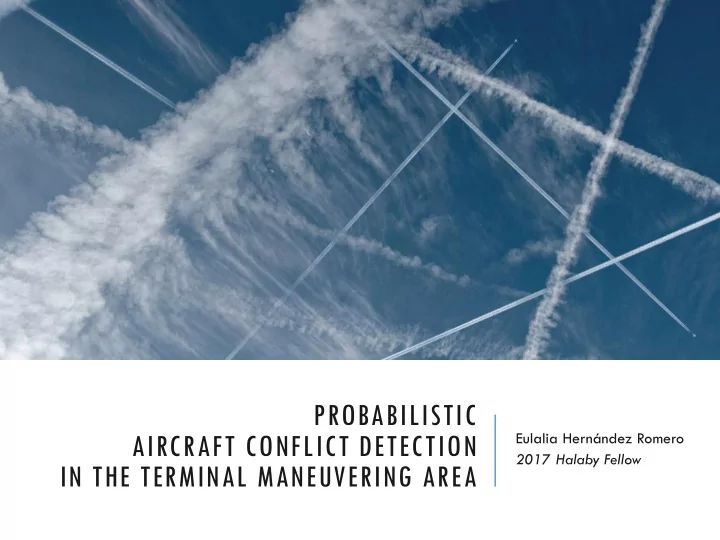

PROBABILISTIC AIRCRAFT CONFLICT DETECTION Eulalia Hernández Romero 2017 Halaby Fellow IN THE TERMINAL MANEUVERING AREA
TABLE OF CONTENTS I. Introduction Slides 3-4 II. Problem formulation Slides 5-7 III. Results Slides 8-12 IV. Summary Slide 13
INTRODUCTION 1. MOTIVATION ▪ The study of the uncertainty present in the Air Traffic Management (ATM) system is a key factor to improve its levels of capacity, efficiency and safety. ▪ Sources of uncertainty: ▪ Uncertainty in data and sensors ▪ Decisions taken by individuals ▪ Weather uncertainty ▪ This project tackles the effects of wind uncertainty on the problem of aircraft conflict detection (CD) in the Terminal Maneuvering Area (TMA) of an airport.
INTRODUCTION 2. APPROACH ▪ How to study the effects on wind uncertainty on the CD problem? 1. Model the aircraft trajectories as random variables 2. Propagate weather uncertainty into the trajectory prediction ▪ Aircraft conflict indicators: ▪ Distance of closest approach ▪ Probability of conflict ▪ Conflict starting time ▪ Conflict duration ▪ … ▪ The wind uncertainty will translate into uncertain conflict indicators
PROBLEM FORMULATION 1. HYPOTHESES ▪ A North-East reference system is used ▪ Two aircraft, A and B, fly with approaching 3D trajectories in the same airspace ▪ The initial positions are certain ▪ An aircraft’s course, airspeed and vertical speeds is known and constant. ▪ The aircraft are affected by the same uncertain horizontal wind. The vertical component of the wind is considered negligible. ▪ The wind is defined by its two components (𝑥 𝑦 and 𝑥 𝑧 ) and it is dependent on the altitude.
PROBLEM FORMULATION 2. CONFLICT DETECTION < 1 𝑄 𝐵 = 𝑦| Ԧ 𝑡 𝐵 − Ԧ Ԧ 𝑦 ▪ A loss of separation is defined when an 2 aircraft violates the protected zone of another aircraft 𝑦 2 + 𝑧 2 , 𝑨 (𝑦, 𝑧, 𝑨) = 𝑛𝑏𝑦 5 NM 𝐸 𝐼 ▪ The distance between A and B is ∆(𝐵, 𝐶) = 𝑡 𝐶 − Ԧ Ԧ 𝑡 𝐵 1000 ft ▪ There is a conflict between aircraft A and B if 𝑛𝑗𝑜 ∆(𝐵, 𝐶) = 𝜀 𝐵, 𝐶 < 1
PROBLEM FORMULATION 3. PROBABILISTIC ANALYSIS Probabilistic wind model Uncertainty propagation method ▪ The wind components are 𝑔 𝑔 defined as random processes: 𝑦 𝑧 𝑥 𝑦 𝑨 = ഥ 𝑥 𝑦 𝑨 + 𝜀 𝑥 𝑦 𝑨 𝑦 Probabilistic 𝑥 𝑧 𝑨 = ഥ 𝑥 𝑧 𝑨 + 𝜀 𝑥 𝑧 𝑨 𝑧 Transformation Method ▪ The random variables x and y range from -1 to 1 𝑔 𝑄 𝑔 𝑦 𝑦 , 𝑦 ∈ −1,1 𝜀 𝐵,𝐶 𝑑𝑝𝑜 𝑔 𝑧 𝑧 , 𝑧 ∈ −1,1
RESULTS 1. CONFLICT SCENARIO: DENVER AIRPORT 34L APPROACH ▪ Descending aircraft approaching a common navigation point. ▪ Simplified 1 segment trajectory
RESULTS 2. WIND DATA: HIGH RESOLUTION RAPID REFRESH (HRRR) ▪ Wind forecast for Nov 13 th 2017 12:00 UTC forecast lead time 2h at 11000ft, merging point AJAKS (39º25’37’’N, 104º42’5’’W)
RESULTS 3. PROBABILISTIC WIND MODEL ▪ Vertical wind profile: mean and dispersion. ▪ Local Eulerian Probabilistic Forecast
RESULTS 4. CONFLICT DETECTION: DETERMINISTIC ANALYSIS ▪ Aircraft distance at closest approach: 𝑒 = 5.02 𝑂𝑁, ℎ = 1001 𝑔𝑢 ▪ No conflict: 𝜀 𝐵, 𝐶 > 1
RESULTS 5. CONFLICT DETECTION: PROBABILISTIC ANALYSIS ▪ Probabilistic analysis: 𝑙 𝑄 𝑑𝑝𝑜 20 km 33.4% 30 km 37.4% 40 km 40.4% The probability of conflict 𝑄 𝑑𝑝𝑜 depends on the wind uncertainty ↑ 𝜀 𝑥 ↑ 𝑄 𝑑𝑝𝑜 Aircraft distance PDFs
SUMMARY FURTHER WORK CONCLUSIONS ▪ Apply the analysis to segmented ▪ Studied propagation of wind trajectories uncertainty to the problem of aircraft conflict detection in the ▪ More realistic wind profiles : TMA ▪ Time and horizontally dependent ▪ The Probabilistic ▪ Different probabilistic Transformation Method has characterization been successfully applied. ▪ Develop a probabilistic resolution ▪ The probability of conflict has strategy to the TMA with the been computed for a conflict objective of decreasing the scenario and altitude dependent probability of conflict. winds, for different wind uncertainties.
THANKS FOR YOUR ATTENTION
Recommend
More recommend